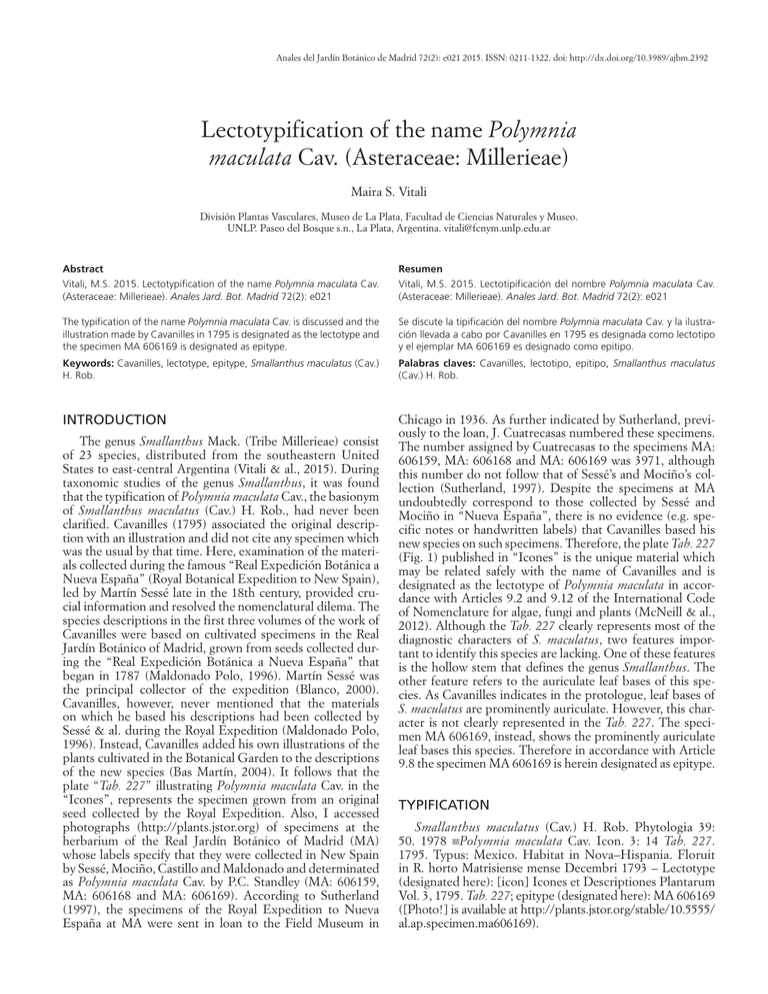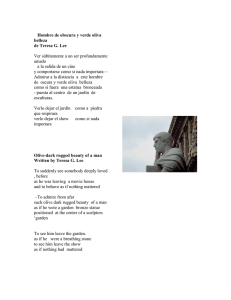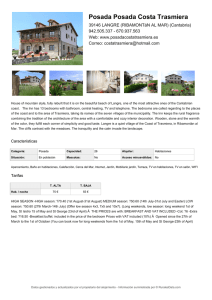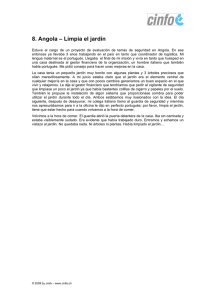Texto completo digital - Naturalis
Anuncio

Anales del Jardín Botánico de Madrid 72(2): e021 2015. ISSN: 0211-1322. doi: http://dx.doi.org/10.3989/ajbm.2392 Lectotypification of the name Polymnia maculata Cav. (Asteraceae: Millerieae) Maira S. Vitali División Plantas Vasculares, Museo de La Plata, Facultad de Ciencias Naturales y Museo. UNLP. Paseo del Bosque s.n., La Plata, Argentina. [email protected] Abstract Vitali, M.S. 2015. Lectotypification of the name Polymnia maculata Cav. (Asteraceae: Millerieae). Anales Jard. Bot. Madrid 72(2): e021 Resumen Vitali, M.S. 2015. Lectotipificación del nombre Polymnia maculata Cav. (Asteraceae: Millerieae). Anales Jard. Bot. Madrid 72(2): e021 The typification of the name Polymnia maculata Cav. is discussed and the illustration made by Cavanilles in 1795 is designated as the lectotype and the specimen MA 606169 is designated as epitype. Se discute la tipificación del nombre Polymnia maculata Cav. y la ilustración llevada a cabo por Cavanilles en 1795 es designada como lectotipo y el ejemplar MA 606169 es designado como epitipo. Keywords: Cavanilles, lectotype, epitype, Smallanthus maculatus (Cav.) H. Rob. Palabras claves: Cavanilles, lectotipo, epitipo, Smallanthus maculatus (Cav.) H. Rob. INTRODUCTION Chicago in 1936. As further indicated by Sutherland, previously to the loan, J. Cuatrecasas numbered these specimens. The ­number assigned by Cuatrecasas to the specimens MA: 606159, MA: 606168 and MA: 606169 was 3971, although this number do not follow that of Sessé’s and Mociño’s collection (Sutherland, 1997). Despite the specimens at MA undoubtedly correspond to those collected by Sessé and Mociño in “Nueva España”, there is no evidence (e.g. specific notes or handwritten labels) that Cavanilles based his new species on such specimens. Therefore, the plate Tab. 227 (Fig. 1) published in “Icones” is the unique material which may be related safely with the name of Cavanilles and is designated as the lectotype of Polymnia maculata in accordance with Articles 9.2 and 9.12 of the International Code of Nomenclature for algae, fungi and plants (McNeill & al., 2012). Although the Tab. 227 clearly represents most of the diagnostic characters of S. maculatus, two features important to identify this species are lacking. One of these features is the hollow stem that defines the genus Smallanthus. The other feature refers to the auriculate leaf bases of this species. As Cavanilles indicates in the protologue, leaf bases of S. maculatus are prominently auriculate. However, this character is not clearly represented in the Tab. 227. The specimen MA 606169, instead, shows the prominently auriculate leaf bases this species. Therefore in accordance with Article 9.8 the specimen MA 606169 is herein designated as epitype. The genus Smallanthus Mack. (Tribe Millerieae) consist of 23 species, distributed from the southeastern United States to east-central Argentina (Vitali & al., 2015). During ­taxonomic studies of the genus Smallanthus, it was found that the typification of Polymnia maculata Cav., the basionym of Smallanthus maculatus (Cav.) H. Rob., had never been clarified. Cavanilles (1795) associated the original description with an illustration and did not cite any specimen which was the usual by that time. Here, examination of the materials collected during the famous “Real Expedición Botánica a Nueva España” (Royal Botanical Expedition to New Spain), led by Martín Sessé late in the 18th century, provided crucial information and resolved the nomenclatural dilema. The species descriptions in the first three volumes of the work of Cavanilles were based on cultivated specimens in the Real Jardín Botánico of Madrid, grown from seeds collected during the “Real Expedición Botánica a Nueva España” that began in 1787 (Maldonado Polo, 1996). Martín Sessé was the principal collector of the expedition (Blanco, 2000). Cavanilles, however, never mentioned that the materials on which he based his descriptions had been collected by Sessé & al. during the Royal Expedition (Maldonado Polo, 1996). Instead, Cavanilles added his own illustrations of the plants cultivated in the Botanical Garden to the descriptions of the new species (Bas Martín, 2004). It follows that the plate “Tab. 227” illustrating Polymnia maculata Cav. in the “Icones”, represents the specimen grown from an original seed collected by the Royal Expedition. Also, I accessed photographs (http://plants.jstor.org) of specimens at the herbarium of the Real Jardín Botánico of Madrid (MA) whose labels specify that they were collected in New Spain by Sessé, Mociño, Castillo and Maldonado and determinated as Polymnia maculata Cav. by P.C. Standley (MA: 606159, MA: 606168 and MA: 606169). According to Sutherland (1997), the specimens of the Royal Expedition to Nueva España at MA were sent in loan to the Field Museum in TYPIFICATION Smallanthus maculatus (Cav.) H. Rob. Phytologia 39: 50. 1978 ≡Polymnia maculata Cav. Icon. 3: 14 Tab. 227. 1795. Typus: Mexico. Habitat in Nova–Hispania. Floruit in R. horto Matrisiense mense Decembri 1793 – Lectotype ­(designated here): [icon] Icones et Descriptiones Plantarum Vol. 3, 1795. Tab. 227; epitype (designated here): MA 606169 ([Photo!] is available at http://plants.jstor.org/stable/10.5555/ al.ap.specimen.ma606169). M.S. Vitali Fig. 1. Lectotype of Polymnia maculata Cav. (Icones et Descriptiones Plantarum Vol. 3, 1795. Tab. 227). Anales del Jardín Botánico de Madrid 72(2): e021 2015. ISSN: 0211-1322. doi: http://dx.doi.org/10.3989/ajbm.2392 2 3 Lectotypification of the name Polymnia maculata Cav. (Asteraceae: Millerieae) ACKNOWLEDGEMENTS I thank the curators of F, G, GH, KEW, MA, S, TEX, and US for providing loans of specimens. I thank Gisela Sancho and Liliana Katinas by suggestions on the manuscript. I want to thank Peter Feinsinger and Iralys Ventosa by their invaluable help during the preparation of the paper. This work was supported by Consejo Nacional de Investigación Científica y Tecnológica (CONICET) and Facultad de Ciencias Naturales y Museo, Universidad Nacional de La Plata (UNLP). BIBLIOGRAPHIC REFERENCES Bas Martín, N. 2004. Una aproximación a la biblioteca del botánico Valenciano Antonio José Cavanilles (1745-1804). Pp 201-285 in: Real Sociedad Económica de Amigos del País, (ed.), Antonio José Cavanilles (1745-1804). Segundo centenario de la muerte de un gran botánico. Valencia. Blanco, P. 2000. Colecciones históricas: el herbario de la Real Expedición Botánica de Nueva España (1787-1803). Boletín de la Asociación de Herbarios Ibero–Macaronésicos 5: 5-10. Cavanilles, A.J. 1795. Icones et Descriptiones Plantarum 3(1): 14. Maldonado Polo, J.L. 1996. Flora de Guatemala de José Mociño. Doce Calles-CSIC Press. Madrid. McNeill, J., Barrie, F.R., Buck, W.R., Demoulin, V., Greuter, W., Hawksworth, D.L., Herenden, P.S., Kanpp, S., Marhold, K., Prado, J., Prud’homme van Reine, W.F., Smith, G.F., Wiersema, J.H. & Turland, N.J. (eds.) 2012. International Code of Nomenclature for algae, fungi and plants (Melbourne Code): adopted by the Eighteenth International Botanical Congress Melbourne, Australia, July 2011. Regnum Vegetabile 154. Königstein: Koeltz Scientific Books. Sutherland, N.C. 1997. Materiales tipo de la colección de Sessé y Mociño en el Real Jardín Botánico de Madrid. Anales Jard. Bot. Madrid. 55 (2): 375-418. http://dx.doi.org/10.3989/ajbm.1997.v55.i2.282 Vitali, M.S, Sancho, G. & Katinas, L. 2015. A Revision of Smallanthus (Asteraceae, Millerieae), the “yacón” genus. Phytotaxa 214 (1): 1-84. http://dx.doi.org/10.11646/phytotaxa.214.1.1 Associate Editor: Enrique Rico Received: 04-VIII-2014 Accepted: 05-X-2015 Anales del Jardín Botánico de Madrid 72(2): e021 2015. ISSN: 0211-1322. doi: http://dx.doi.org/10.3989/ajbm.2392






